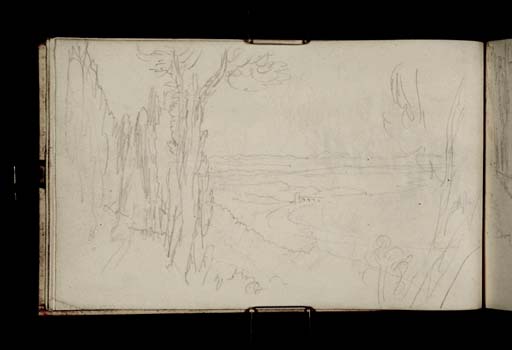Joseph Mallord William Turner View from Monte Mario, Rome, with the Ponte Molle and the River Tiber 1819
Image 1 of 2
Joseph Mallord William Turner,
View from Monte Mario, Rome, with the Ponte Molle and the River Tiber
1819
Joseph Mallord William Turner 1775–1851
Folio 9 Verso:
View from Monte Mario, Rome, with the Ponte Molle and the River Tiber 1819
D16174
Turner Bequest CLXXXVIII 9 a
Turner Bequest CLXXXVIII 9 a
Pencil on white wove paper, 114 x 189 mm
Accepted by the nation as part of the Turner Bequest 1856
References
1909
A.J. Finberg, A Complete Inventory of the Drawings of the Turner Bequest, London 1909, vol.I, p.558, as ‘Tiber in mid-distance, with Ponte Molle (?)’.
The panorama of Rome as seen from the heights of Monte Mario was one of the most frequently depicted views in the Italian topographical tradition. John Chetwode Eustace, author of A Classical Tour in Italy described the view from the Villa Mellini (now the Rome Observatory) on the summit of the hill:
The Tiber intersecting the city and winding through rich meadows; the Prata Quintia and Prata Mutia, fields still bearing their names, the trophies of Roman virtue and Roman heroism; the Pons Milvius with its tower, and the plains consecrated by the victory of Constantine; the Vatican Palace with its courts and gardens; the Basilica of St Peter with its portico, its obelisk, and its fountains, the Campus Martius covered with the churches, squares and palaces of the modern city; the seven hills strewed with ruins of the ancient; the walls with their towers and galleries; the desert Campagna, with Mount Soracte rising apparently in the centre; and the semi-circular sweep of mountains tinged with blue or purple, now bright with the sun, now dark in the shade, and generally gleaming with snow – such is the varied and magnificent scene spread out before the traveller, while reposing on the shaded terrace of Villa Mellini.1
Turner made a number of on-the-spot sketches and more elaborate drawings of the view during his 1819 sojourn in Rome. This page depicts part of the prospect, the view looks north-east towards the sweeping bend of the River Tiber and the ancient Ponte Molle, also known as the Ponte Milvio. This crossing carried the Via Flaminia across the Tiber into Rome and hence was the entry and exit point for British tourists to and from the city during the nineteenth century. Famous as the site of the deciding battle between Emperors Constantine and Maxentius in 312 AD, the bridge is recognisable from the four central arches spanning the river (there were also two smaller arches at either end not clearly visible from a distance) and an entrance tower on the northern end (left) which had been rebuilt in 1805.2 As a young man, Turner had made a number of watercolour copies of images of the bridge with his contemporary, Thomas Girtin for Dr Monro’s Album of Italian Views, 1794–6 (see Tate D36443–D36445; Turner Bequest CCCLXXIII 30–32). In the far distance is the mountain ridge of Monte Sorratte, known historically as Soracte. Turner’s viewpoint was a spot in the grounds of the Villa Madama, another villa with terraced gardens which lies further north from the Villa Mellini on the lower slopes of the hill, see folio 13 verso (D16182). The composition is very similar to James Hakewill’s drawing of the same subject, View of the Ponte Molle and the Tiber, Looking across the Campagna to the Sabine Mountains 1816.3 Turner made a number of sketches of the view towards Ponte Molle from Monte Mario, see folios 10, 10 verso, 11, 13 verso, 14 (D16175, D16176, D16177, D16182, D16183). He also completed tonal and coloured studies of a similar view in the Small Roman C. Studies sketchbook (see Tate D16444, and D16481; Turner Bequest CXC 33a and 64), and the Roman Colour Studies sketchbook (see Tate D16391; Turner Bequest CLXXXIX 60).
Looking south-east from the Monte Mario, to the right of the Ponte Molle, was an unparalleled view across the heart of the city itself, see folios 11 verso and 12 (D16178–D16179). Prior to embarking upon his first trip to Italy, Turner had completed a watercolour of this panorama, Rome, from the Monte Mario (Yale Center for British Art, Paul Mellon Center), 1818, based upon another drawing by Hakewill. 4 This illustration was engraved by John Byrne for Hakewill’s Picturesque Tour of Italy, 1818 (Tate, T06020).5
Nicola Moorby
September 2008
For a detailed sketch of the bridge prior to 1805 see William Marlow (1740–1813), Ponte Molle, pencil on paper, Tate T09173.
Tony Cubberley and Luke Herrmann, Twilight of the Grand Tour: A catalogue of the drawings by James Hakewill inthe British School at Rome Library, Rome 1992, p.185. no.3.4, reproduced.
How to cite
Nicola Moorby, ‘View from Monte Mario, Rome, with the Ponte Molle and the River Tiber 1819 by Joseph Mallord William Turner’, catalogue entry, September 2008, in David Blayney Brown (ed.), J.M.W. Turner: Sketchbooks, Drawings and Watercolours, Tate Research Publication, December 2012, https://www


